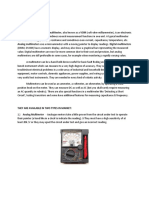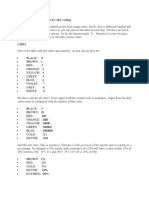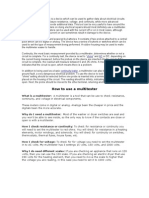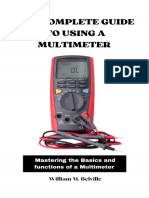Multimeters: Choosing A Multimeter
Multimeters: Choosing A Multimeter
Uploaded by
ronniedakingpouCopyright:
Available Formats
Multimeters: Choosing A Multimeter
Multimeters: Choosing A Multimeter
Uploaded by
ronniedakingpouOriginal Title
Copyright
Available Formats
Share this document
Did you find this document useful?
Is this content inappropriate?
Copyright:
Available Formats
Multimeters: Choosing A Multimeter
Multimeters: Choosing A Multimeter
Uploaded by
ronniedakingpouCopyright:
Available Formats
3/29/2011
Multimeters
Home | Map | Projects | Construction | Soldering | Study | Components | 555 | Symbols | FAQ | Links
Multimeters
Choosing | Digital | Analogue | Voltage & Current | Resistance | Diode | Transistor
Next Page: Resistance Also See: Meters | Voltage and Current Multimeters are very useful test instruments. By operating a multi-position switch on the meter they can be quickly and easily set to be a voltmeter, an ammeter or an ohmmeter. They have several settings (called 'ranges') for each type of meter and the choice of AC or DC. Some multimeters have additional features such as transistor testing and ranges for measuring capacitance and frequency.
Liquid-Crystal Display (LCD)
Choosing a multimeter
The photographs below show modestly priced multimeters which are suitable for general electronics use, you should be able to buy meters like these for less than 15. A digital multimeter is the best choice for your first multimeter, even the cheapest will be suitable for testing simple projects. If you are buying an analogue multimeter make sure it has a high sensitivity of 20k /V or greater on DC voltage ranges, anything less is not suitable for electronics. The sensitivity is normally marked in a corner of the scale, ignore the lower AC value (sensitivity on AC ranges is less important), the higher DC value is the critical one. Beware of cheap analogue multimeters sold for electrical work on cars because their sensitivity is likely to be too low.
Digital multimeters
All digital meters contain a battery to power the display so they use virtually no power from the circuit under test. This means that on their DC voltage ranges they have a very high resistance (usually called input impedance) of 1M or more, usually 10M , and they are very unlikely to affect the circuit under test. Typical ranges for digital multimeters like the one illustrated:
(the values given are the maximum reading on each range)
DC Voltage: 200mV, 2000mV, 20V, 200V, 600V. AC Voltage: 200V, 600V. DC Current: 200A, 2000A, 20mA, 200mA, 10A*. *The 10A range is usually unfused and connected via a special socket.
www.kpsec.freeuk.com/multimtr.htm
Digital Multimeter
Photograph Rapid Electronics 1/7
3/29/2011
Multimeters
Photograph Rapid Electronics AC Current: None. (You are unlikely to need to measure this). Resistance: 200 , 2000 , 20k , 200k , 2000k , Diode Test.
Digital meters have a special diode test setting because their resistance ranges cannot be used to test diodes and other semiconductors.
Top of page | Choosing | Digital | Analogue | Voltage & Current | Resistance | Diode | Transistor
Analogue multimeters
Analogue meters take a little power from the circuit under test to operate their pointer. They must have a high sensitivity of at least 20k /V or they may upset the circuit under test and give an incorrect reading. See the section below on sensitivity for more details. Batteries inside the meter provide power for the resistance ranges, they will last several years but you should avoid leaving the meter set to a resistance range in case the leads touch accidentally and run the battery flat. Typical ranges for analogue multimeters like the one illustrated:
(the voltage and current values given are the maximum reading on each range)
Analogue Multimeter
Photograph Rapid Electronics
DC Voltage: 0.5V, 2.5V, 10V, 50V, 250V, 1000V. AC Voltage: 10V, 50V, 250V, 1000V. DC Current: 50A, 2.5mA, 25mA, 250mA.
A high current range is often missing from this type of meter. AC Current: None. (You are unlikely to need to measure this).
Resistance: 20 , 200 , 2k , 20k , 200k .
These resistance values are in the middle of the scale for each range.
It is a good idea to leave an analogue multimeter set to a DC voltage range such as 10V when not in use. It is less likely to be damaged by careless use on this range, and there is a good chance that it will be the range you need to use next anyway! Sensitivity of an analogue multimeter Multimeters must have a high sensitivity of at least 20k /V otherwise their resistance on DC voltage ranges may be too low to avoid upsetting the circuit under test and giving an incorrect reading. To obtain valid readings the meter resistance should be at least 10 times the circuit resistance (take this to be the highest resistor value near where the meter is connected). You can increase the meter resistance by selecting a higher voltage range, but this may give a reading which is too small to read accurately! On any DC voltage range: Analogue Meter Resistance = Sensitivity Max. reading of range e.g. a meter with 20k /V sensitivity on its 10V range has a resistance of 20k /V 10V = 200k .
www.kpsec.freeuk.com/multimtr.htm
2/7
3/29/2011
Multimeters
By contrast, digital multimeters have a constant resistance of at least 1M (often 10M ) on all their DC voltage ranges. This is more than enough for almost all circuits.
Top of page | Choosing | Digital | Analogue | Voltage & Current | Resistance | Diode | Transistor
Measuring voltage and current with a multimeter
1. Select a range with a maximum greater than you expect the reading to be. 2. Connect the meter, making sure the leads are the correct way round.
Digital meters can be safely connected in reverse, but an analogue meter may be damaged.
3. If the reading goes off the scale: immediately disconnect and select a higher range. Multimeters are easily damaged by careless use so please take these precautions: Always disconnect the multimeter before adjusting the range switch. Always check the setting of the range switch before you connect to a circuit. Never leave a multimeter set to a current range (except when actually taking a reading).
The greatest risk of damage is on the current ranges because the meter has a low resistance.
Measuring voltage at a point When testing circuits you often need to find the voltages at various points, for example the voltage at pin 2 of a 555 timer IC. This can seem confusing - where should you connect the second multimeter lead? Connect the black (negative -) lead to 0V, normally the negative terminal of the battery or power supply. Connect the red (positive +) lead to the point you where you need to measure the voltage. The black lead can be left permanently connected to 0V while you use the red lead as a Measuring voltage at a point. probe to measure voltages at various points. You may wish to fit a crocodile clip to the black lead of your multimeter to hold it in place while doing testing like this. Voltage at a point really means the voltage difference between that point and 0V (zero volts) which is normally the negative terminal of the battery or power supply. Usually 0V will be labelled on the circuit diagram as a reminder. Reading analogue scales Check the setting of the range switch and
www.kpsec.freeuk.com/multimtr.htm 3/7
3/29/2011
Multimeters
choose an appropriate scale. For some ranges you may need to multiply or divide by 10 or 100 as shown in the sample readings below. For AC voltage ranges use the red markings because the calibration of the scale is slightly different. Sample readings on the scales shown: DC 10V range: 4.4V (read 0-10 scale directly) DC 50V range: 22V (read 0-50 scale directly) DC 25mA range: 11mA (read 0-250 and divide by
10)
AC 10V range: 4.45V (use the red scale, reading
0-10)
Analogue Multimeter Scales
These can appear daunting at first but remember that you only need to read one scale at a time! The top scale is used when measuring resistance.
If you are not familiar with reading analogue scales generally you may wish to see the analogue display section on the general meters page.
Top of page | Choosing | Digital | Analogue | Voltage & Current | Resistance | Diode | Transistor
Measuring resistance with a multimeter
To measure the resistance of a component it must not be connected in a circuit. If you try to measure resistance of components in a circuit you will obtain false readings (even if the supply is disconnected) and you may damage the multimeter. The techniques used for each type of meter are very different so they are treated separately: Measuring resistance with a DIGITAL multimeter 1. Set the meter to a resistance range greater than you expect the resistance to be.
Notice that the meter display shows "off the scale" (usually blank except for a 1 on the left). Don't worry, this is not a fault, it is correct - the resistance of air is very high!
2. Touch the meter probes together and check that the meter reads zero.
If it doesn't read zero, turn the switch to 'Set Zero' if your meter has this and try again.
3. Put the probes across the component.
Avoid touching more than one contact at a time or your resistance will upset the reading!
Measuring resistance with an ANALOGUE multimeter The resistance scale on an analogue meter is normally at the top, it is an unusual scale because it reads backwards and is not linear (evenly spaced). This is unfortunate, but it is due to the way the meter works. 1. Set the meter to a suitable resistance range.
Choose a range so that the resistance you expect will be near the middle of the scale. For example: with the
www.kpsec.freeuk.com/multimtr.htm 4/7
3/29/2011
Multimeters
scale shown below and an expected resistance of about 50k
choose the 1k
range.
2. Hold the meter probes together and adjust the control on the front of the meter which is usually labelled "0 ADJ" until the pointer reads zero (on the RIGHT remember!).
If you can't adjust it to read zero, the battery inside the meter needs replacing.
3. Put the probes across the component.
Avoid touching more than one contact at a time or your resistance will upset the reading!
Reading analogue resistance scales For resistance use the upper scale, noting that it reads backwards and is not linear (evenly spaced). Check the setting of the range switch so that you know by how much to multiply the reading. Sample readings on the scales shown: 10 range: 260 1k range: 26k If you are not familiar with reading analogue scales generally you may wish to see the analogue display section on the general meters page. Analogue Multimeter Scales
The resistance scale is at the top, note that it reads backwards and is not linear (evenly spaced).
Top of page | Choosing | Digital | Analogue | Voltage & Current | Resistance | Diode | Transistor
Testing a diode with a multimeter
The techniques used for each type of meter are very different so they are treated separately: Testing a diode with a DIGITAL multimeter Digital multimeters have a special setting for testing a diode, usually labelled with the diode symbol. Connect the red (+) lead to the anode and the black (-) to the cathode. The diode should conduct and the meter will display a value (usually the voltage across the diode in mV, 1000mV = 1V). Reverse the connections. The diode should NOT conduct this way so the meter will display "off the scale" (usually blank except for a 1 on the left). Testing a diode with an ANALOGUE multimeter Set the analogue multimeter to a low value resistance range such as 10.
www.kpsec.freeuk.com/multimtr.htm 5/7
Diodes
a = anode k = cathode
3/29/2011
Multimeters
It is essential to note that the polarity of analogue multimeter leads is reversed on the resistance ranges, so the black lead is positive (+) and the red lead is negative (-)! This is unfortunate, but it is due to the way the meter works. Connect the black (+) lead to anode and the red (-) to the cathode. The diode should conduct and the meter will display a low resistance (the exact value is not relevant). Reverse the connections. The diode should NOT conduct this way so the meter will show infinite resistance (on the left of the scale). For further information please see the diodes page. You may find it easier to test a diode with the simple tester project.
Top of page | Choosing | Digital | Analogue | Voltage & Current | Resistance | Diode | Transistor
Testing a transistor with a multimeter
Set a digital multimeter to diode test and an analogue multimeter to a low resistance range such as 10, as described above for testing a diode. Test each pair of leads both ways (six tests in total): The base-emitter (BE) junction should behave like a diode and conduct one way only. The base-collector (BC) junction should behave like a diode and conduct one way only. The collector-emitter (CE) should not conduct either way.
Testing an NPN transistor
The diagram shows how the junctions behave in an NPN transistor. The diodes are reversed in a PNP transistor but the same test procedure can be used. For further information please see the transistors page. You may find it easier to test a transistor with the simple tester project. Some multimeters have a 'transistor test' function, please refer to the instructions supplied with the meter for details.
Top of page | Choosing | Digital | Analogue | Voltage & Current | Resistance | Diode test | Transistor
Next Page: Resistance | Studying Electronics
www.kpsec.freeuk.com/multimtr.htm
6/7
3/29/2011
Multimeters
Electronics Club Home Page Site Map Example Projects Construction of Projects Soldering Guide Study Electronics Electronic Components 555 Timer Circuit Symbols Frequently Asked Questions Links to other Electronics sites
John Hewes 2010, The Electronics Club, www.kpsec.freeuk.com
www.kpsec.freeuk.com/multimtr.htm
7/7
You might also like
- Digital Multimeter DT830 Series ManualDocument12 pagesDigital Multimeter DT830 Series ManualJohn G.75% (4)
- Introduction To The Multi MeterDocument3 pagesIntroduction To The Multi MeterFaiz FauziNo ratings yet
- Analog Multimeters Use A Microammeter With A Moving Pointer To Display Readings. Digital MultimetersDocument5 pagesAnalog Multimeters Use A Microammeter With A Moving Pointer To Display Readings. Digital Multimeterswaar lockNo ratings yet
- Multimeter ExpDocument3 pagesMultimeter ExpArun JyothiNo ratings yet
- A Study On Multimeter PDFDocument5 pagesA Study On Multimeter PDFNishanth.M nishuNo ratings yet
- Background and Special Items To Note:: Wolf/Smith, Student Reference Manual For Electronic Instrumentation LaboratoriesDocument3 pagesBackground and Special Items To Note:: Wolf/Smith, Student Reference Manual For Electronic Instrumentation LaboratoriesHafidz YoshiokaNo ratings yet
- 7. Principles in Operating MultimetersDocument6 pages7. Principles in Operating MultimetersGwyn Angelie ErecreNo ratings yet
- Experiment No 1Document13 pagesExperiment No 1Norman ElizagaNo ratings yet
- AssignmentDocument8 pagesAssignmentHxrish DanixlNo ratings yet
- E 3042 - Instrumentation 1: Ske4BDocument20 pagesE 3042 - Instrumentation 1: Ske4BZaidi OsmanNo ratings yet
- How To Use A MultimeterDocument16 pagesHow To Use A Multimetershayma ahmedNo ratings yet
- Nothing Special 4Document25 pagesNothing Special 4Jester SubiaNo ratings yet
- MultitesterDocument3 pagesMultitesterChin-Chin AbejarNo ratings yet
- Measuring Stuff With A MultimeterDocument32 pagesMeasuring Stuff With A MultimeterDamodaran SrinivasanNo ratings yet
- Basic Electrical Measuring Instruments: by Pramod ADocument31 pagesBasic Electrical Measuring Instruments: by Pramod Akevinwz1989No ratings yet
- Applied Physics: Lab ManualDocument13 pagesApplied Physics: Lab ManualMuhammad Ahsan ShahèénNo ratings yet
- How To Use A Multimeter Simplified - A Complete DIY Step by Step Guide On How To Use MultimeterDocument43 pagesHow To Use A Multimeter Simplified - A Complete DIY Step by Step Guide On How To Use MultimeterWilliam BautistaNo ratings yet
- Division of Ilocos Norte Electronics Product Assembly and Servicing Week 3 - 4 MultitesterDocument4 pagesDivision of Ilocos Norte Electronics Product Assembly and Servicing Week 3 - 4 MultitesterJovy DumlaoNo ratings yet
- DIGITAL MULTIMETER FOR BEGINNERS - Joe Martins (BooxRack)Document45 pagesDIGITAL MULTIMETER FOR BEGINNERS - Joe Martins (BooxRack)pc16aipanstikanpurNo ratings yet
- Testing A CapacitorDocument4 pagesTesting A Capacitorroman reeseNo ratings yet
- Hardware Tools: Multimeter UseDocument5 pagesHardware Tools: Multimeter UseColin ArndtNo ratings yet
- Digital Multimeter - Basic GuideDocument4 pagesDigital Multimeter - Basic GuidetowfiqeeeNo ratings yet
- FINAL EXPERIMENT 1 (29.11.2019) - With FigsDocument8 pagesFINAL EXPERIMENT 1 (29.11.2019) - With FigsMd HamzaNo ratings yet
- Electrical Units of MeasurementDocument17 pagesElectrical Units of Measurementapi-3842326100% (1)
- How To Use A Multimeter Simplified - A Complete DIY Step by Step Guide On How To Use A Multimeter To Measure Voltage, Current, Resistance, Continuity and in Troubleshooting Circuits PDFDocument30 pagesHow To Use A Multimeter Simplified - A Complete DIY Step by Step Guide On How To Use A Multimeter To Measure Voltage, Current, Resistance, Continuity and in Troubleshooting Circuits PDFilovepieriaNo ratings yet
- Describe How To Use Multimeters To Measure CurrentDocument25 pagesDescribe How To Use Multimeters To Measure CurrentKobby BrineNo ratings yet
- DIGITAL MULTIMETER FOR BEGINNERS - Complete Step by Step Guide On How To Use All The Functions On Your Digital MultimeterDocument48 pagesDIGITAL MULTIMETER FOR BEGINNERS - Complete Step by Step Guide On How To Use All The Functions On Your Digital Multimeterthanathos1233699No ratings yet
- DIGITAL MULTI-METER - The Definitive Guide On To Effectively Use Your Digital Multi-Meter PDFDocument50 pagesDIGITAL MULTI-METER - The Definitive Guide On To Effectively Use Your Digital Multi-Meter PDFHerman HeseNo ratings yet
- Multimeter TesterDocument32 pagesMultimeter TesterMarjenneil0% (1)
- How To Measure Resistance by Color CodingDocument8 pagesHow To Measure Resistance by Color CodingCarl John SedimoNo ratings yet
- 1 Introduction To MultimeterDocument12 pages1 Introduction To MultimeterHalo GaisNo ratings yet
- Multimeter - Wikipedia, The Free EncyclopediaDocument13 pagesMultimeter - Wikipedia, The Free Encyclopediad_richard_dNo ratings yet
- How To Use A MultimeterDocument6 pagesHow To Use A MultimeterjackNo ratings yet
- How To Use Digital MultimeterDocument23 pagesHow To Use Digital Multimeternafees100% (2)
- How To Use A MultimeterDocument4 pagesHow To Use A Multimetermario_1303No ratings yet
- Digitech MultimeterDocument7 pagesDigitech Multimeterpropaganda65No ratings yet
- Emt 2422 L3Document29 pagesEmt 2422 L3Fred MuthokaNo ratings yet
- NE344 Lab1 Laboratory InstrumentsDocument22 pagesNE344 Lab1 Laboratory Instrumentsmmaa86No ratings yet
- Analog MultimetersDocument7 pagesAnalog MultimeterssattiyanNo ratings yet
- Electrical Test EquipmentsDocument17 pagesElectrical Test Equipmentsengrroy100% (2)
- EE 442 Laboratory Experiment 2 Introduction To The Measurement of Voltage, Current, Resistance and Voltmeter LoadingDocument12 pagesEE 442 Laboratory Experiment 2 Introduction To The Measurement of Voltage, Current, Resistance and Voltmeter LoadingAdrien Munyaneza100% (1)
- How To Use VomDocument60 pagesHow To Use VomJhella Ochoa JuacallaNo ratings yet
- EE11L Lab ManualDocument56 pagesEE11L Lab ManualDonutdealerd100% (1)
- Multimeter GUIDELINEDocument14 pagesMultimeter GUIDELINEAmirul SyazwanNo ratings yet
- Digital Multimeter: Owner'S ManualDocument21 pagesDigital Multimeter: Owner'S ManualUjjwal Kr. AcharyyaNo ratings yet
- Analog and Digital MultitesterDocument31 pagesAnalog and Digital MultitesterCedric Montiano100% (2)
- The MultitesterpowerpointDocument21 pagesThe MultitesterpowerpointAngel AlarasNo ratings yet
- 3.4. MultimeterDocument5 pages3.4. MultimeterEveNo ratings yet
- User GuideDocument8 pagesUser GuideAdam SonenshineNo ratings yet
- Activity 2 Measurement DiscussionDocument5 pagesActivity 2 Measurement DiscussionJoel Kelly MabaoNo ratings yet
- Introduction To Lab EquipmentDocument5 pagesIntroduction To Lab EquipmentKashif Mujeeb Abdul MujeebNo ratings yet
- Using The MultimeterDocument5 pagesUsing The MultimeterAlfred GaleaNo ratings yet
- Quantities MeasuredDocument56 pagesQuantities MeasuredMaryam Adila JusohNo ratings yet
- A Multi Tester orDocument4 pagesA Multi Tester orSarah Marie Nueva SierraNo ratings yet
- William M Belville - The Complete Guide To Using A Multimeter - Mastering The Basics and Functions of A Multimeter-Amazon Digital Services LLC - KDP (2023) - 2Document76 pagesWilliam M Belville - The Complete Guide To Using A Multimeter - Mastering The Basics and Functions of A Multimeter-Amazon Digital Services LLC - KDP (2023) - 2sayid khalif100% (2)
- Fluke Type 73 Digital MultimeterDocument7 pagesFluke Type 73 Digital MultimeterAbiyot AderieNo ratings yet
- 1 (PV Solar Simulator)Document3 pages1 (PV Solar Simulator)ronniedakingpouNo ratings yet
- 01 - CC (GE NEMA Size)Document212 pages01 - CC (GE NEMA Size)ronniedakingpouNo ratings yet
- 1 (PV Solar Simulator)Document3 pages1 (PV Solar Simulator)ronniedakingpouNo ratings yet
- ChessDocument2 pagesChessronniedakingpouNo ratings yet
- Kyocera 70 MW PV Solar Power PlantDocument3 pagesKyocera 70 MW PV Solar Power PlantronniedakingpouNo ratings yet
- Omniksol-3.0k & 4.0k&5.0k Specs - V2.2Document2 pagesOmniksol-3.0k & 4.0k&5.0k Specs - V2.2ronniedakingpouNo ratings yet
- 100 KW InverterDocument2 pages100 KW InverterronniedakingpouNo ratings yet
- Omniksol-3.0k & 4.0k&5.0k Specs - V2.2Document2 pagesOmniksol-3.0k & 4.0k&5.0k Specs - V2.2ronniedakingpouNo ratings yet
- Help - Gaisma (Sunrise Sunset)Document3 pagesHelp - Gaisma (Sunrise Sunset)ronniedakingpouNo ratings yet
- Lead-Acid Battery: Index DC Circuits BatteriesDocument3 pagesLead-Acid Battery: Index DC Circuits BatteriesronniedakingpouNo ratings yet
- CEPALCO 1-MW Photovoltaic Power Plant - Vista PinasDocument5 pagesCEPALCO 1-MW Photovoltaic Power Plant - Vista PinasronniedakingpouNo ratings yet
- Dhananjay Pathak: Created by As An To YouDocument19 pagesDhananjay Pathak: Created by As An To YouronniedakingpouNo ratings yet
- 701 Maryland To 100 Hawthorn DriveDocument1 page701 Maryland To 100 Hawthorn DriveronniedakingpouNo ratings yet






































































